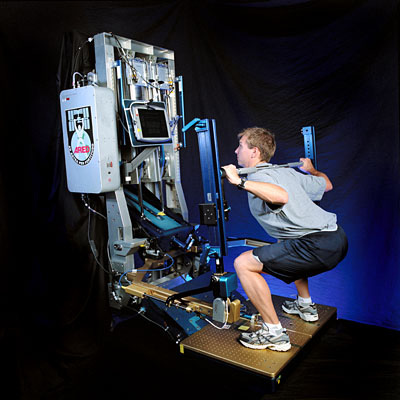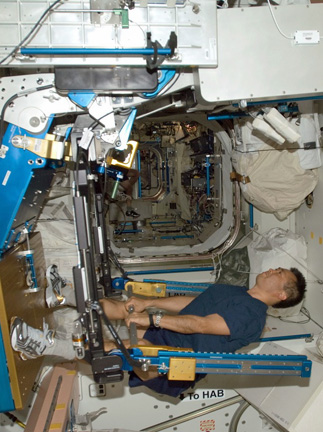Study suggests astronauts need better exercise
08/18/2010 03:30 PM Filed in: Space News | International Space Station
A new study shows that despite regular exercise, astronauts on long-duration spaceflights experience significant muscle wasting and a surprising loss of force, reducing their efficiency in space and their ability to respond to emergencies when returning to Earth.
The research suggests the reduction in the capacity for work after six months in space can exceed 40 percent, which would reduce the performance of a returning astronaut to that of an 80-year-old. The study indicates more effective exercise techniques are required to keep astronauts fit during long missions.
Robert Fitts of Marquette University, lead author of a paper published this week in the Journal of Physiology, said bed-rest studies show resistive exercise can offset the decline. A sophisticated new exercise machine aboard the International Space Station may be the type of countermeasure long-duration crews need, but so far, no studies have been carried out to prove it.
"No one's tested it," Fitts told CNET in a telephone interview. "I think it needs to be tested. They could start by doing some very well controlled bed-rest studies, which has been the model for a long time. ... And then, also start testing the actual crew using it on the station. I know they're using it, but it's like a lot of things, nobody's getting any data that says it's working."
That is about to change. Lori Ploutz-Snyder, a scientist with NASA's exercise countermeasures project at the Johnson Space Center in Houston, said a new study using the space station's Advanced Resistive Exercise Device, or ARED, will collect some of the data Fitts says is needed.
 The Advanced Resistive Exercise Device now aboard the
The Advanced Resistive Exercise Device now aboard the
International Space Station. (Photo: NASA)
"From my perspective, what is exciting about Fitts' work is not that he showed that there's muscle atrophy with spaceflight, because that's been known for a long time," she said. "But his data point to some mechanisms and some reasons why, one of those being exercise intensity.The research suggests the reduction in the capacity for work after six months in space can exceed 40 percent, which would reduce the performance of a returning astronaut to that of an 80-year-old. The study indicates more effective exercise techniques are required to keep astronauts fit during long missions.
Robert Fitts of Marquette University, lead author of a paper published this week in the Journal of Physiology, said bed-rest studies show resistive exercise can offset the decline. A sophisticated new exercise machine aboard the International Space Station may be the type of countermeasure long-duration crews need, but so far, no studies have been carried out to prove it.
"No one's tested it," Fitts told CNET in a telephone interview. "I think it needs to be tested. They could start by doing some very well controlled bed-rest studies, which has been the model for a long time. ... And then, also start testing the actual crew using it on the station. I know they're using it, but it's like a lot of things, nobody's getting any data that says it's working."
That is about to change. Lori Ploutz-Snyder, a scientist with NASA's exercise countermeasures project at the Johnson Space Center in Houston, said a new study using the space station's Advanced Resistive Exercise Device, or ARED, will collect some of the data Fitts says is needed.
 The Advanced Resistive Exercise Device now aboard the
The Advanced Resistive Exercise Device now aboard theInternational Space Station. (Photo: NASA)
"We suspected that all along, which is one reason we flew the ARED in the first place. But we also are just embarking on a new research study with a higher intensity exercise program and his data were very timely in that it really encouraged us that that is, in fact, the way to go."
Fitts' team collected pre- and post-flight needle biopsies of muscle tissue from five NASA astronauts and five Russian cosmonauts returning to Earth aboard Soyuz spacecraft. The post-landing samples were collected immediately after landings in Kazakhstan and shipped back to labs in the U.S. One sample was damaged during transit and not used
"We knew the muscle fibers were going to be smaller ... based on the data from the Mir (space station) and even Skylab," Fitts said. "We were surprised, though, that not only was there atrophy but there was structural re-arrangement of the fibers such that there was a greater loss in force than there was atrophy."
Researchers also noticed a reduction in the speed at which muscle fibers could contract, or shorten.
"And of course power, which is a product of the force and the velocity, dropped more than any of these others because both the velocity and the force were dropping," Fitts said. "The decrease in velocity was real surprising because we had done a study on the shuttle in '96, it was a 17-day flight, where velocity actually increased and there had been a structural re-arrangement we thought was a nice adaptation. It turned out that was a transient adaptation."
 An astronaut working out on the ARED aboard
An astronaut working out on the ARED aboardthe space station. (Photo: NASA)
The study raises questions about how healthy astronauts might be returning to Earth after long-duration flights aboard the space station or even longer voyages to nearby asteroids or, eventually, Mars. Given the long round-trip travel times, returning astronauts might not be up to dealing with a landing emergency.
"What we're saying is there's a significant drop in power when they first come back that could be a problem if they had to egress rapidly or do heavy work rapidly," Fitts said.
Astronauts aboard the International Space Station typically spend 45 minutes to an hour or so every day actually exercising, either pedaling a stationary bike, jogging on a treadmill, held down by a harness, or using resistive devices. Counting preparation time, crew members devote two hours a day to getting the required exercise done.
The ARED, one of the latest exercise machines aboard the station, works like a high-tech gym to permit effective weight lifting with up to 600 pounds of load, using flywheels to simulate the inertia weight lifters must overcome.
"One question I commonly get is why would you ever need 600 pounds? Who can squat 600?" Ploutz-Snyder said. "The answer for that is, on the ground you wouldn't need 600 pounds because you're also probably lifting half of your body weight. But in flight, you're not. So you have to add your body weight back into the equation."
The new exercise study will have astronauts spend less time working out, but doing it at a higher intensity.
"For weightlifting, higher intensity means heavier weights and for aerobic exercise, it means faster speeds," she said. "We're adding in some aerobic interval work where you run really fast and then rest. We're trying to reduce our total exercise time and increase the intensity."
She said the new study should answer some of the questions raised in the Fitts team research, "so I think this does tell sort of a nice story in the university partnership doing basic science research that we can translate into an operational program."